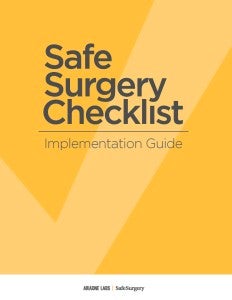Ariadne Labs’ most established and well-recognized work has been improving the safety of surgery worldwide with the Safe Surgery Checklist. Developed with the World Health Organization and now used in some 50 million of 300 million operations performed globally, the checklist has been shown to reduce surgical complications and mortality by 18 to 47 percent. But successfully implementing the checklist involves more than hanging it on an OR wall.

After years of research and learning in more than 4,000 facilities, Ariadne Labs has just released a new Safe Surgery Checklist Implementation Guide, a 318-page pathway through the entire process of improving surgery at the hospital level. It can be viewed and downloaded here. Ariadne Labs communications manager Deborah O’Neil recently sat down with Dr. William Berry, Ariadne Labs’ chief medical officer and Safe Surgery Program director, to talk about safe surgery and the development of the new guide.
Let’s start with the Safe Surgery Checklist. Tell us about its origins and development.
The WHO surgical safety checklist is a widely used tool to improve the safety of surgery and operating rooms around the world. It was a product of partnership between the WHO, and the team at Ariadne Labs, and many other people around the globe who contributed. It addresses critical issues in making sure that every patient who undergoes a surgical procedure has it performed as safely as possible, every time.
Now we have a new guide for implementation of the checklist. Is this the first Implementation Guide?
If you go to the WHO website, the Surgical Safety checklist is up there with an implementation guide. It is about seven pages long, and basically includes everything that we knew or felt would be important to give people to successfully implement the WHO checklist at the time it was written in 2008. If you look closely, it really shows the genes, if you will, of the larger implementation guide, which is clearly derived from that initial work.
The initial implementation guide sounds like the skeleton for the new guide you developed.
Yes if the seven pages was a skeleton, this is what the person looks like. The current version is a product of a lot more work, a lot more failure, and a lot more learning, that has come from our work globally and our work in South Carolina implementing the checklist. It is very practical. It is not filled with theories and academics. It is filled with, ‘If I want to do this, what do I need to do?’
What implementation work has informed the new guide?
We had done scattered implementation work through the WHO, but the WHO didn’t have the assets or the people to update the manual as we were learning things out in the world.
Meanwhile, the South Carolina Hospital Association (SCHA) reached out to Atul and he’d asked them to commit to putting the checklist into place around the state. Backed by the support of a generous private funder, the SCHA took him up on the idea to work with the state of South Carolina over five years, with an eye towards expanding the work beyond that to other states. South Carolina was a huge implementation experiment, and we made a difference. The checklist is probably more widely, fully implemented in South Carolina than it is anywhere else in the whole country. In terms of the spirit of the checklist, there are hospitals there that really use it well.
In the beginning, we didn’t really know how to help people implement a major change in the operating room. This was our first chance to really get close to the ground. We looked around, we tried to find large-scale implementation projects of a similar nature, there wasn’t much. Dr. Peter Pronovost at Johns Hopkins had done some seminal work in the state of Michigan to implement a checklist, which actually inspired the original WHO checklist. He focused on ICUs to reduce the rate of deadly infections associated with central line catheters, and he’d shown you could do it, and at scale. Then we gathered anything we could find about implementation the experiences in businesses and corporations and in the federal government.
So you had a partner in South Carolina and you had a checklist to implement and funding to do it, but the question was, how?
That’s right. The initial investment was in creating a 19-part webinar series for hospitals in South Carolina. It was clear at the end of the 19 webinars over six-months that we were moving too fast. They couldn’t keep up because the work took longer than that, and we clearly didn’t have it down.
We did the webinar series two more times and it went from 19 to 15 to 9. The message got crisper and crisper. Each time, the next one incorporated learning after the series was done. We learned from direct hospital contacts what worked, what didn’t work, what they wish we’d done. We also learned from interacting with them at in-person meetings.
It sounds like the webinars were the first draft of your implementation guide.
Right. And when Ashley Kay Childers, our PhD partner from Clemson University in South Carolina, started doing hospital visits to coach operating room teams, she was also gathering information on implementation. We took those learnings to make the webinars series even better. With additional private funding, we worked with a designer in Seattle, Chris Barnes, who put a team together to go through all the webinars, transcribe them, and then turn the content outline for the manual. Then, the manual was created by me, Chris and our program manager Lizzie Edmondson.
That’s a tremendous amount of work.
It’s unbelievable. And if a hospital follows it, it’s a path that can work. It has a very high likelihood of succeeding.
Who is the audience for this guide? And what level do you see it being used? Is it for one surgeon? A hospital? A health system?
The ultimate target is at the level of a hospital operating suite. But it could be useful to someone who’s trying to coordinate a state effort to look at all the content that they might want to provide if they were running a state effort. And I think it has helpful information for anyone trying to bring change to frontline care and culture and not just related to checklists.
It’s a path drawn from practical experience. It starts with, ‘I want to do this,’ all the way to, ‘Okay, I’ve finished implementing, now what should I do?’ It answers a lot of questions. How do I maintain the tool? How do I make sure people don’t stop using it? It has lots of tools within it and is very easy to use. So if you want to do a culture survey in your operating rooms at your hospital, you go to the index, click on a link that says culture survey and it’ll take you to the survey tool.
It’s got this rich collection of tools that are modifiable and downloadable. Things like a coaching tool, an observation tool, templates for spreadsheets. It lets people pick and choose. You can read chapter headings, you can read a brief summary of what’s in the chapter, or you can go deep where it will actually tell you how to coach, how to teach coachers, how to recruit coaches. All the pieces of how to implement the Safe Surgery Checklist are in there.
It sounds like you tried to anticipate every question that might come up.
We did, and I have to give credit enough to the whole team. Jim Sachetta, one of our program managers, had a major part in the webinar series and making all that work for us. Project manager Katie Jahreis contributed to gathering data and background. It was a big team that contributed.
In the end, when Lizzie, Chris and I were working on it, that was exactly what we were trying to do, answer all the questions. We’d watched people stumble at every point and fall off the track. And so it tries to address most of the stumbles.
If I’m a hospital administrator and I come across this implementation guide, do I have to work with Ariadne Labs or is it meant to stand alone?
It’s meant to stand alone. It’s meant to be useful in anybody’s hands anywhere. They don’t have to necessarily work with us, though we love to hear from people about their experiences and suggestions for improving it.
So the guide is done, what’s next?
The guide is not perfect. It needs to change more and be adapted in a meaningful way. Philanthropy was critical in bringing the guide this far. We couldn’t have done it without the help of some very generous individuals and foundations. Support from donors will be crucial to help us work in sites overseas to figure out how to make it context sensitive. It was written from the U.S. experience technically to be used in U.S. hospitals with U.S. culture. We have a different hospital culture than the rest of the world. There’s a different way of approaching modifications if you’re in Zambia or Uganda, than there is if you’re in South Carolina.
Why is implementing a checklist so hard? Everyone wants patients to be safe.
For a whole bunch of reasons. Most of the people who work in an OR every day are really good at working around problems. That is a widespread skill in health care. There are a lot of problems in the system and if you’re going to keep your patient in front of you as safe as you can, you learn how to help your patient navigate around the problems.
If you go to healthcare providers and ask them, most think they provide pretty safe care. They might think the system around them isn’t safe. Nurses will tell us that the system has a bunch of bad stuff, but they will also repeat the mantra that “my own personal physician is great.” And that makes a huge implementation challenge because they can’t see the reason why they personally should change their practices. So you’re a surgeon, you’ve been doing surgery for 20 years, and if you thought what you were doing was unsafe, you wouldn’t do it. You don’t want to hurt anyone. So you have this group of people with the mindset of, we try to fix the problems we see and the ones we can’t fix, we work around. We’re doing as good as we can, and keeping the patients safe. So you’re trying to get me to change my workflow, think about doing something different, and I don’t really need that.
It is a huge sales job in the beginning to convince people that okay, most of the time you do a great job, but it’s too much to hurt 1 in 1,000 patients. That’s too much. If one in 1,000 airplane flights crash, there’d be two crashes on the front page everyday. We wouldn’t tolerate it. But if 1,000 patients walk into the hospital, it’s somehow okay that one doesn’t walk out because of a problem with their care that was avoidable.
How does a checklist help shift that deeply ingrained outlook?
What you’re really trying to do is change a culture with this tool. We say that the checklist is made up of “checks” and “prompts”. A check means to check that a process was completed. A prompt is to make sure some important communication has occurred. And the checklist has both for a reason. A lot of the checks get done, and a lot of the checks are pretty well done, because we’ve been at improving those since the late 1990s, but the prompts to me are what provide the safety net under the patient when something, perhaps unanticipated, goes wrong. You end up with a team that’s communicating better in the OR because they were on the same page at the beginning of the operation. When something doesn’t go right, a well-functioning team walks away from the operating table with a patient minimally injured. A poorly functioning team can look like a three ring circus and the patient can end up with an injury that might have been prevented.
It’s almost a revolutionary idea. With all skills, training and technical expertise and the technology that comes to bear on the surgical table, what really improves care is talking to one another.
When I was a practicing surgeon I started out absolutely old school. I actually had a name for it – “need to know.” There was a lot of information about the patient and it made me angry when I’d walk in the OR ready to do the operation and people started peppering me with questions. I was like, ‘You don’t need to know that, don’t bother me.’ Over time, though, as I did very complex surgeries, I learned that the people who surround you are part of the care team. By the end of my career, I would always explain why the patient was there and what we were going to do and what we needed to be ready for. And it changed everything. I saw up front and personal how it changed what happened in the OR, and honestly, it changed my attitude.
If you think way into the future, what do you hope will come of these tools you’ve developed?
To me what really matters is planting a seed and watering it and getting the seedling to sprout, but you’re not really making progress until some other seeds come up around you. The exciting part to me is seeing other people start to take it on, because that’s what is going to move the needle. We can’t move it on our own. That’s why we made the implementation manual, to give people a map to follow in the hopes that they can bring this incredibly valuable tool to every patient, every time.





